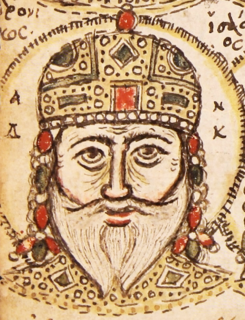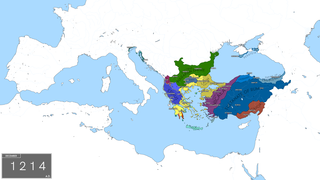
Alexios III Angelos was Byzantine Emperor from March 1195 to 17/18 July 1203. He reigned under the name Alexios Komnenos, associating himself with the Komnenos dynasty. A member of the extended imperial family, Alexios came to the throne after deposing, blinding and imprisoning his younger brother Isaac II Angelos. The most significant event of his reign was the attack of the Fourth Crusade on Constantinople in 1203, on behalf of Alexios IV Angelos. Alexios III took over the defence of the city, which he mismanaged, and then fled the city at night with one of his three daughters. From Adrianople, and then Mosynopolis, he attempted unsuccessfully to rally his supporters, only to end up a captive of Marquis Boniface of Montferrat. He was ransomed and sent to Asia Minor where he plotted against his son-in-law Theodore I Laskaris, but was eventually captured and spent his last days confined to the Monastery of Hyakinthos in Nicaea, where he died.

Andronikos I Komnenos, Latinized as Andronicus I Comnenus, was Byzantine emperor from 1183 to 1185. He was the son of Isaac Komnenos and the grandson of the emperor Alexios I. In later Byzantine historiography, Andronikos I became known under the epithet "Misophaes" in reference to the great number of enemies he had blinded.

Isaac II Angelos was Byzantine Emperor from 1185 to 1195, and again from 1203 to 1204.

John II Komnenos or Comnenus was Byzantine emperor from 1118 to 1143. Also known as "John the Beautiful" or "John the Good", he was the eldest son of Emperor Alexios I Komnenos and Irene Doukaina and the second emperor to rule during the Komnenian restoration of the Byzantine Empire. As he was born to a reigning emperor, he had the status of a porphyrogennetos. John was a pious and dedicated monarch who was determined to undo the damage his empire had suffered following the Battle of Manzikert, half a century earlier.

Theodore I Laskaris or Lascaris was the first emperor of Nicaea—a successor state of the Byzantine Empire—from 1205 to his death. Although he was born to an obscure aristocratic family, his mother was related to the imperial Komnenos clan. He married Anna, a younger daughter of Emperor Alexios III Angelos in 1200. He received the title of despot before 1203, demonstrating his right to succeed his father-in-law on the throne.
Theodore Branas or Vranas, sometimes called Theodore Komnenos Branas, was a general under the Byzantine Empire and afterwards under the Latin Empire of Constantinople. Under the Latin regime he was given the title Caesar and in 1206 he became governor and lord of Adrianople. He is called Livernas by western chroniclers of the Fourth Crusade, including Geoffroi de Villehardouin.

The Empire of Nicaea or the Nicene Empire is the conventional historiographic name for the largest of the three Byzantine Greek rump states founded by the aristocracy of the Byzantine Empire that fled after Constantinople was occupied by Western European and Venetian armed forces during the Fourth Crusade, a military event known as the Sack of Constantinople. Like other Byzantine rump states that formed after the 1204 fracturing of the empire, such as the Empire of Trebizond and the Empire of Thessalonica, it was a continuation of the eastern half of the Roman Empire that survived well into the medieval period. A fourth state, known in historiography as the Latin Empire, was established by an army of Crusaders and the Republic of Venice after the capture of Constantinople and the surrounding environs.
Agnes of France, renamed Anna, was Byzantine Empress by marriage to Alexios II Komnenos and Andronikos I Komnenos. She was a daughter of Louis VII of France and Adèle of Champagne.
Ivan Asen I, also known as Asen I or John Asen I, was emperor or tsar of Bulgaria from 1187/1188 to 1196 as co-ruler with his elder brother, Peter II. Hailing from the Byzantine theme of Paristrion, his exact place and date of birth are unknown. Although most contemporaneous chronicles describe Asen and his brothers, Theodor (Peter) and Kaloyan, as Vlachs, they were probably of mixed Vlach, Bulgarian, and Cuman ancestry.
AlexiosBranas or Vranas was a Byzantine nobleman, attempted usurper, and the last Byzantine military leader of the 12th century to gain a notable success against a foreign enemy.
Manuel Kamytzes Komnenos Doukas Angelos was a Byzantine general who was active in the late 12th century, and led an unsuccessful rebellion in 1201–02, against his cousin, Emperor Alexios III Angelos.
The House of Angelos, feminine form Angelina (Ἀγγελίνα), plural Angeloi (Ἄγγελοι), was a Byzantine Greek noble lineage which rose to prominence through the marriage of its founder, Constantine Angelos, with Theodora Komnene, the youngest daughter of Emperor Alexios I Komnenos. As imperial relatives, the Angeloi held various high titles and military commands under Emperor Manuel I Komnenos. In 1185, following a revolt against Andronikos I Komnenos, Isaac II Angelos rose to the throne, the first of three Angeloi emperors who ruled until 1204. The period was marked by the decline and fragmentation of the Byzantine Empire, culminating in its dissolution by the Fourth Crusade in 1204.
Manuel Komnenos was the eldest son of Byzantine emperor Andronikos I Komnenos, and the progenitor of the Grand Komnenos dynasty of the Empire of Trebizond. He served his uncle, Manuel I Komnenos, as a diplomatic envoy to the Russian principalities and the Kingdom of Jerusalem, but also helped his father escape imprisonment in Constantinople. His opposition to the regency of Empress-dowager Maria of Antioch and the protosebastos Alexios Komnenos landed him in prison, but he was released in April 1182, when his father stood poised to take power in the Byzantine capital.
Nikephoros Melissenos, Latinized as Nicephorus Melissenus, was a Byzantine general and aristocrat. Of distinguished lineage, he served as a governor and general in the Balkans and Asia Minor in the 1060s. In the turbulent period after the Battle of Manzikert in 1071, when several generals tried to seize the throne for themselves, Melissenos remained loyal to Michael VII Doukas and was exiled by his successor Nikephoros III Botaneiates. In 1080–1081, with Turkish aid, he seized control of what remained of Byzantine Asia Minor and proclaimed himself emperor against Botaneiates. After the revolt of his brother-in-law Alexios I Komnenos, however, which succeeded in taking Constantinople, he submitted to him, accepting the rank of Caesar and the governance of Thessalonica. He remained loyal to Alexios thereafter, participating in most Byzantine campaigns of the period 1081–1095 in the Balkans at the emperor's side. He died on 17 November 1104.

Wars between the Normans and the Byzantine Empire were fought from c. 1040 until 1185, when the last Norman invasion of the Byzantine Empire was defeated. At the end of the conflict, neither the Normans nor the Byzantines could boast much power, as by the mid-13th century exhaustive fighting with other powers had weakened both, leading to the Byzantines losing Asia Minor to the Ottoman Empire in the 15th century, and the Normans losing Sicily to the Hohenstaufen.
Pseudo-Alexios II was the most famous among several pretenders to the throne of the Byzantine Empire who appeared in the early reign of Isaac II Angelos. He claimed to be the Emperor Alexios II Komnenos, who had been murdered in 1183.
The sack of Thessalonica in 1185 by Normans of the Kingdom of Sicily was one of the worst disasters to befall the Byzantine Empire in the 12th century.
John Kantakouzenos was a military commander and an early member of the Kantakouzenos family. The contemporary historian Niketas Choniates describes him as a brave, audacious and experienced soldier but frequently led astray by his foolhardiness and presumption.
Constantine Mesopotamites was a senior Byzantine official, and de facto chief minister under the emperors Isaac II Angelos and Alexios III Angelos from 1193 until his fall in summer 1197. He was also archbishop of Thessalonica from c. 1197 until c. 1227, but was in exile between 1204 and 1224, when the city was occupied by Latin Crusaders. Restored to his see, he refused to crown Theodore Komnenos Doukas as emperor, and departed his see again in self-exile. He was also a colleague and correspondent of the historian Niketas Choniates, and may have commissioned some of the latter's works.
Isaac Komnenos Vatatzes was a Byzantine aristocrat and military commander, who was the son-in-law of Emperor Alexios III Angelos and received the rank of sebastokrator.







